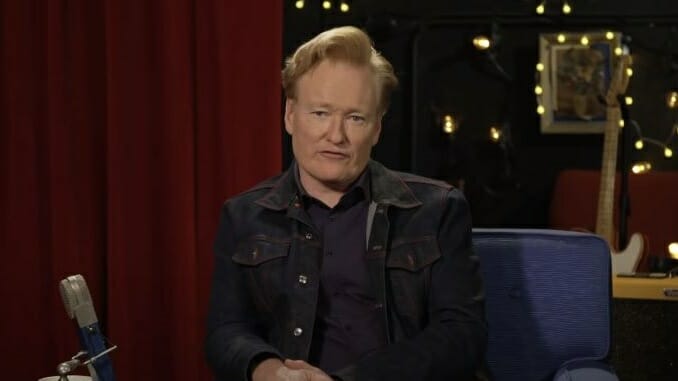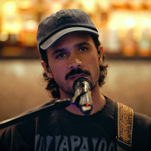Why Does Late Night Still Exist?

It’s the end of an era as Conan O’Brien is set to shut down his late night talk show, Conan, for good. O’Brien was arguably one of late night’s best hosts starting from his days on NBC’s Late Night back in 1993 before his (forced) transition to TBS. His career trajectory runs parallel to the genre’s own evolution, moving from the vaunted network desks to cable, before later switching from the traditional hour-long show format to a half-hour structure that aimed to bridge the gap between old school and new. And now he’ll move to streaming, with a new variety show coming to HBO Max in the future.
While O’Brien ultimately stayed true to late night’s roots, Conan has evolved better than his predecessors. Institutions like The Tonight Show, Late Night, and The Late Show have struggled to adapt to the changing landscape across the internet and social media, politics, and celebrity. Traditional late night is a relic of the past. Instead of constant rebranding, it would serve better to take its final bow and set the stage for the next generation of late night programming, one better suited for today’s TV viewer.
In many ways, the internet killed the late night star. Late night was born early in TV’s history, when there were only a few channels and at a time where a TV in every house was not a given like it is today. It rose to a place of cultural dominance as TV became more and more common, and by the late ‘60s and ‘70s Johnny Carson and his Tonight Show held significant sway over the public. Networks have been chasing that prominence ever since, despite social and technological changes making it impossible for that to happen again.
Cable fractured the traditional TV model in the ‘80s, but the rise of the internet and social media was an entire cultural reset for Hollywood. With the overwhelming number of viewing options and mediums to choose from, late night faces stiffer competition than ever. Most of late night’s viewership comes from their live broadcasts, but the very demographics they try to court the most (18-49) are now the ones most likely to cut the cord.
Today, most people have a TV but not cable, opting for a cache of media subscriptions instead. Late night depends on traditional viewership patterns. With the internet, who is staying up to catch the world premiere of a new movie trailer or celebrity interview when you can go to bed and watch it on YouTube the next day? Twitter is a dagger into the heart of the monologue. Even when shooting four-to-fives shows a week, the internet moves too fast for TV. Why stay up past midnight on a weekday to catch the same jokes you’ve read 100 times on Twitter already? TV is becoming less and less of a suitable medium for late night as we know it. Its individual parts have found better homes elsewhere.
Along with how we consume TV, how we interact with celebrity culture has faced its own significant shift. While the monologue sets the tone for the show, the bulk of the program belongs to celebrity interviews. While some stars like Paul Rudd and the late Charles Grodin have established reputations for being great guests, the vast majority of these interviews are instantly forgettable. They’re ust plain PR sponcon during a time where we are bombarded with sponsored content everywhere we look.
While we’ve always known celebrities are not as relatable as they try to appear, the one-of-us image is no longer attractive. The fakeness of these interviews became ever more obvious in the pandemic-born Zoom-based episodes. Without a shared stage presence, the hosts lack the charm that is needed to convincingly create a facade of longtime friendship and appreciation for their guests who, by and large, are not as interesting as their PR machines make them out to be. Though we should all know by now how these things work, with anecdotes and bits pre-planned, the puppet strings became ostentatious.
Like a lot of entertainment media, celebrity culture was a form of escapism. We enjoyed peering into a life of luxury most of us will never see. While social media has made this easier than ever by giving celebrities control over their own image, it also killed all the fun (and some reputations). From Gal Gadot’s “Imagine” video to Chrissy Teigen’s endlessly tone-deaf humblebrags, we’ve seen that celebrities are, in fact, not like us. More than that, their wealth and privilege is no longer viewed as inspiring but odious. Late night is largely a PR tool, one that celebrities no longer have to depend on, and one audiences no longer have the patience to suspend disbelief for.
Celebrity is a waning currency. The kind of viewers who would watch a talk show on a television don’t want fluff anymore; they want thoughtful interviews from people with real journalistic brains that know how to dig into and analyze art, or the relaxed frankness that comes from a true familiar face talking to their subject like a friend and not the other half of a vaudevillian stage act on opening night. Whether via a podcast or a magazine, the removal of an audience leads to more authenticity from those few celebs that are actually interesting. The rigermorole of the armchair carousel is unsatisfying compared to it. Today, people would rather hear Marc Maron interview John Waters for 90 minutes on WTF than watch him play board games for a few minutes with Jimmy Fallon. As Julie Klausner’s remarks in Difficult People, Jimmy Fallon has basically “turned The Tonight Show into a children’s birthday party.”
-

-

-

-

-

-

-

-

-

-

-

-

-

-

-

-

-

-

-

-

-

-

-

-

-

-

-

-

-

-

-

-

-

-

-

-

-

-

-

-








































